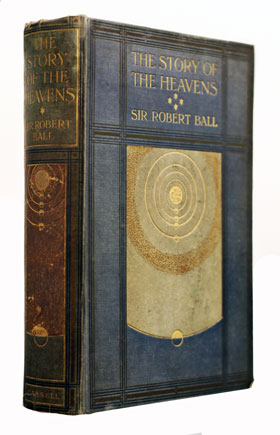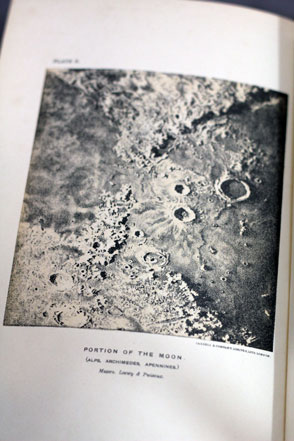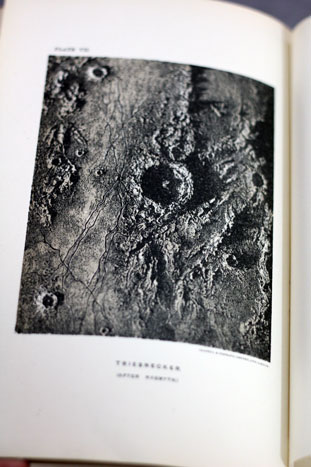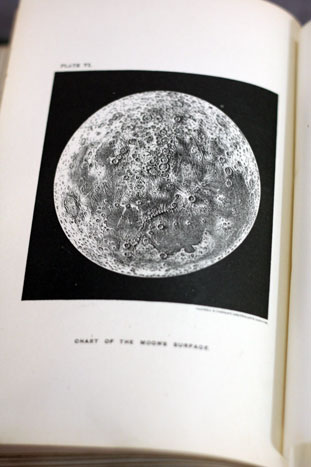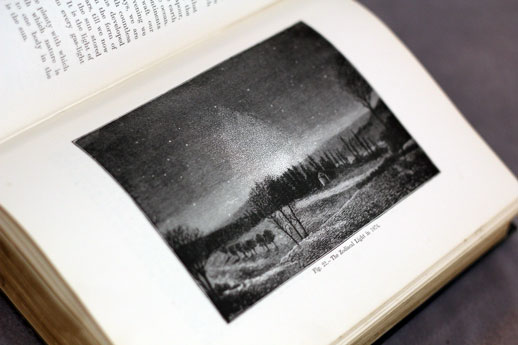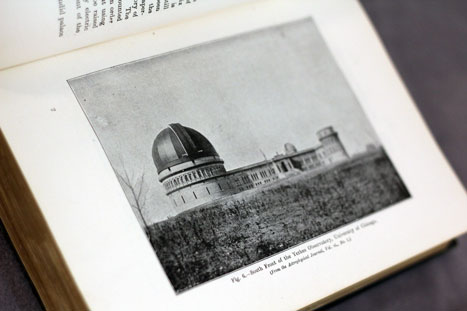A fascinating window into human knowledge of astronomy from roughly a century ago.
Contents:
I. The Astronomical Observatory 9
II. The Sun 29
III. The Moon 70
IV. The Solar System 107
V. The Law of Gravitation 122
VI. The Planet of Romance 150
VII. Mercury 155
VIII. Venus 167
IX. The Earth 192
X. Mars 208
XI. The Minor Planets 229
XII. Jupiter 245
XIII. Saturn 268
XIV. Uranus 298
XV. Neptune 315
XVI. Comets 336
XVII. Shooting Stars 372
XVIII. The Starry Heavens 409
XIX. The Distant Suns 425
XX. Double Stars 434
XXI. The Distances of the Stars 441
XXII. Star Clusters and Nebulæ 461
XXIII. The Physical Nature of the Stars 477
XXIV. The Precession and Nutation of the Earth’s Axis 492
XXV. The Aberration of Light 503
XXVI. The Astronomical Significance of Heat 513
XXVII. The Tides 531
Appendix 558
About the author (from wikipedia):
Sir Robert Stawell Ball FRS (1840 – 1913) was an Irish astronomer. In 1867 he became Professor of Applied Mathematics at the Royal College of Science in Dublin. In 1874 Ball was appointed Royal Astronomer of Ireland and Andrews Professor of Astronomy in the University of Dublin at Dunsink Observatory. In 1892 he was appointed Lowndean Professor of Astronomy and Geometry at Cambridge University at the same time becoming director of the Cambridge Observatory. His lectures, articles and books (e.g. Starland and The Story of the Heavens) were mostly popular and simple in style. However, he also published books on mathematical astronomy such as A Treatise on Spherical Astronomy. His main interest was mathematics and he devoted much of his spare time to his “Screw theory”. He served for a time as President of the Quaternion Society. His work The Story of the Heavens is mentioned in the “Ithaka” chapter of James Joyce’s Ulysses.
He was the son of naturalist Robert Ball and Amelia Gresley Hellicar.
Introduction
The Story of the Heavens” is the title of our book. We have indeed a wondrous story to narrate; and could we tell it adequately it would prove of boundless interest and of exquisite beauty. It leads to the contemplation of grand phenomena in nature and great achievements of human genius.
Let us enumerate a few of the questions which will be naturally asked by one who seeks to learn something of those glorious bodies which adorn our skies: What is the Sun—how hot, how big, and how distant? Whence comes its heat? What is the Moon? What are its landscapes like? How does our satellite move? How is it related to the earth? Are the planets globes like that on which we live? How large are they, and how far off? What do we know of the satellites of Jupiter and of the rings of Saturn? How was Uranus discovered? What was the intellectual triumph which brought the planet Neptune to light? Then, as to the other bodies of our system, what are we to say of those mysterious objects, the comets? Can we discover the laws of their seemingly capricious movements? Do we know anything of their nature and of the marvellous tails with which they are often decorated? What can be told about the shooting-stars which so often dash into our atmosphere and perish in a streak of splendour? What is the nature of those constellations of bright stars which have been recognised from all antiquity, and of the host of smaller stars which our telescopes disclose? Can it be true that these countless orbs are really majestic suns, sunk to an appalling depth in the abyss of unfathomable space? What have we to tell of the different varieties of stars—of coloured stars, of variable stars, of double stars, of multiple stars, of stars that seem to move, and of stars that seem at rest? What of those glorious objects, the great star clusters? What of the Milky Way? And, lastly, what can we learn of the marvellous nebulæ which our telescopes disclose, poised at an immeasurable distance? Such are a few of the questions which occur when we ponder on the mysteries of the heavens.
The history of Astronomy is, in one respect, only too like many other histories. The earliest part of it is completely and hopelessly lost. The stars had been studied, and some great astronomical discoveries had been made, untold ages before those to which our earliest historical records extend. For example, the observation of the apparent movement of the sun, and the discrimination between the planets and the fixed stars, are both to be classed among the discoveries of prehistoric ages. Nor is it to be said that these achievements related to matters of an obvious character. Ancient astronomy may seem very elementary to those of the present day who have been familiar from childhood with the great truths of nature, but, in the infancy of science, the men who made such discoveries as we have mentioned must have been sagacious philosophers.
Of all the phenomena of astronomy the first and the most obvious is that of the rising and the setting of the sun. We may assume that in the dawn of human intelligence these daily occurrences would form one of the first problems to engage the attention of those whose thoughts rose above the animal anxieties of everyday existence. A sun sets and disappears in the west. The following morning a sun rises in the east, moves across the heavens, and it too disappears in the west; the same appearances recur every day. To us it is obvious that the sun, which appears each day, is the same sun; but this would not seem reasonable to one who thought his senses showed him that the earth was a flat plain of indefinite extent, and that around the inhabited regions on all sides extended, to vast distances, either desert wastes or trackless oceans. How could that same sun, which plunged into the ocean at a fabulous distance in the west, reappear the next morning at an equally great distance in the east? The old mythology asserted that after the sun had dipped in the western ocean at sunset (the Iberians, and other ancient nations, actually imagined that they could hear the hissing of the waters when the glowing globe was plunged therein), it was seized by Vulcan and placed in a golden goblet. This strange craft with its astonishing cargo navigated the ocean by a northerly course, so as to reach the east again in time for sunrise the following morning. Among the earlier physicists of old it was believed that in some manner the sun was conveyed by night across the northern regions, and that darkness was due to lofty mountains, which screened off the sunbeams during the voyage.
In the course of time it was thought more rational to suppose that the sun actually pursued his course below the solid earth during the course of the night. The early astronomers had, moreover, learned to recognise the fixed stars. It was noticed that, like the sun, many of these stars rose and set in consequence of the diurnal movement, while the moon obviously followed a similar law. Philosophers thus taught that the various heavenly bodies were in the habit of actually passing beneath the solid earth.
By the acknowledgment that the whole contents of the heavens performed these movements, an important step in comprehending the constitution of the universe had been decidedly taken. It was clear that the earth could not be a plane extending to an indefinitely great distance. It was also obvious that there must be a finite depth to the earth below our feet. Nay, more, it became certain that whatever the shape of the earth might be, it was at all events something detached from all other bodies, and poised without visible support in space. When this discovery was first announced it must have appeared a very startling truth. It was so difficult to realise that the solid earth on which we stand reposed on nothing! What was to keep it from falling? How could it be sustained without tangible support, like the legendary coffin of Mahomet? But difficult as it may have been to receive this doctrine, yet its necessary truth in due time commanded assent, and the science of Astronomy began to exist. The changes of the seasons and the recurrence of seed-time and harvest must, from the earliest times, have been associated with certain changes in the position of the sun. In the summer at mid-day the sun rises high in the heavens, in the winter it is always low. Our luminary, therefore, performs an annual movement up and down in the heavens, as well as a diurnal movement of rising and setting. But there is a third species of change in the sun’s position, which is not quite so obvious, though it is still capable of being detected by a few careful observations, if combined with a philosophical habit of reflection. The very earliest observers of the stars can hardly have failed to notice that the constellations visible at night varied with the season of the year. For instance, the brilliant figure of Orion, though so well seen on winter nights, is absent from the summer skies, and the place it occupied is then taken by quite different groups of stars. The same may be said of other constellations. Each season of the year can thus be characterised by the sidereal objects that are conspicuous by night. Indeed, in ancient days, the time for commencing the cycle of agricultural occupations was sometimes indicated by the position of the constellations in the evening.
By reflecting on these facts the early astronomers were enabled to demonstrate the apparent annual movement of the sun. There could be no rational explanation of the changes in the constellations with the seasons, except by supposing that the place of the sun was altering, so as to make a complete circuit of the heavens in the course of the year. This movement of the sun is otherwise confirmed by looking at the west after sunset, and watching the stars. As the season progresses, it may be noticed each evening that the constellations seem to sink lower and lower towards the west, until at length they become invisible from the brightness of the sky. The disappearance is explained by the supposition that the sun appears to be continually ascending from the west to meet the stars. This motion is, of course, not to be confounded with the ordinary diurnal rising and setting, in which all the heavenly bodies participate. It is to be understood that besides being affected by the common motion our luminary has a slow independent movement in the opposite direction; so that though the sun and a star may set at the same time to-day, yet since by to-morrow the sun will have moved a little towards the east, it follows that the star must then set a few minutes before the sun.
The patient observations of the early astronomers enabled the sun’s track through the heavens to be ascertained, and it was found that in its circuit amid the stars and constellations our luminary invariably followed the same path. This is called the ecliptic, and the constellations through which it passes form a belt around the heavens known as the zodiac. It was anciently divided into twelve equal portions or “signs,” so that the stages on the sun’s great journey could be conveniently indicated. The duration of the year, or the period required by the sun to run its course around the heavens, seems to have been first ascertained by astronomers whose names are unknown. The skill of the early Oriental geometers was further evidenced by their determination of the position of the ecliptic with regard to the celestial equator, and by their success in the measurement of the angle between these two important circles on the heavens.
The principal features of the motion of the moon have also been noticed with intelligence at an antiquity more remote than history. The attentive observer perceives the important truth that the moon does not occupy a fixed position in the heavens. During the course of a single night the fact that the moon has moved from west to east across the heavens can be perceived by noting its position relatively to adjacent stars. It is indeed probable that the motion of the moon was a discovery prior to that of the annual motion of the sun, inasmuch as it is the immediate consequence of a simple observation, and involves but little exercise of any intellectual power. In prehistoric times also, the time of revolution of the moon had been ascertained, and the phases of our satellite had been correctly attributed to the varying aspect under which the sun-illuminated side is turned towards the earth.
But we are far from having exhausted the list of great discoveries which have come down from unknown antiquity. Correct explanations had been given of the striking phenomenon of a lunar eclipse, in which the brilliant surface is plunged temporarily into darkness, and also of the still more imposing spectacle of a solar eclipse, in which the sun itself undergoes a partial or even a total obscuration. Then, too, the acuteness of the early astronomers had detected the five wandering stars or planets: they had traced the movements of Mercury and Venus, Mars, Jupiter, and Saturn. They had observed with awe the various configurations of these planets: and just as the sun, and in a lesser degree the moon, were intimately associated with the affairs of daily life, so in the imagination of these early investigators the movements of the planets were thought to be pregnant with human weal or human woe. At length a certain order was perceived to govern the apparently capricious movements of the planets. It was found that they obeyed certain laws. The cultivation of the science of geometry went hand in hand with the study of astronomy: and as we emerge from the dim prehistoric ages into the historical period, we find that the theory of the phenomena of the heavens possessed already some degree of coherence.
Ptolemy, following Pythagoras, Plato, and Aristotle, acknowledged that the earth’s figure was globular, and he demonstrated it by the same arguments that we employ at the present day. He also discerned how this mighty globe was isolated in space. He admitted that the diurnal movement of the heavens could be accounted for by the revolution of the earth upon its axis, but unfortunately he assigned reasons for the deliberate rejection of this view. The earth, according to him, was a fixed body; it possessed neither rotation round an axis nor translation through space, but remained constantly at rest in what he supposed to be the centre of the universe. According to Ptolemy’s theory the sun and the moon moved in circular orbits around the earth in the centre. The explanation of the movements of the planets he found to be more complicated, because it was necessary to account for the fact that a planet sometimes advanced and that it sometimes retrograded. The ancient geometers refused to believe that any movement, except revolution in a circle, was possible for a celestial body: accordingly a contrivance was devised by which each planet was supposed to revolve in a circle, of which the centre described another circle around the earth.
Although the Ptolemaic doctrine is now known to be framed on quite an extravagant estimate of the importance of the earth in the scheme of the heavens, yet it must be admitted that the apparent movements of the celestial bodies can be thus accounted for with considerable accuracy. This theory is described in the great work known as the “Almagest,” which was written in the second century of our era, and was regarded for fourteen centuries as the final authority on all questions of astronomy.
Such was the system of Astronomy which prevailed during the Middle Ages, and was only discredited at an epoch nearly simultaneous with that of the discovery of the New World by Columbus. The true arrangement of the solar system was then expounded by Copernicus in the great work to which he devoted his life. The first principle established by these labours showed the diurnal movement of the heavens to be due to the rotation of the earth on its axis. Copernicus pointed out the fundamental difference between real motions and apparent motions; he proved that the appearances presented in the daily rising and setting of the sun and the stars could be accounted for by the supposition that the earth rotated, just as satisfactorily as by the more cumbrous supposition of Ptolemy. He showed, moreover, that the latter supposition must attribute an almost infinite velocity to the stars, so that the rotation of the entire universe around the earth was clearly a preposterous supposition. The second great principle, which has conferred immortal glory on Copernicus, assigned to the earth its true position in the universe. Copernicus transferred the centre, about which all the planets revolve, from the earth to the sun; and he established the somewhat humiliating truth, that our earth is merely a planet pursuing a track between the paths of Venus and of Mars, and subordinated like all the other planets to the supreme sway of the Sun.
This great revolution swept from astronomy those distorted views of the earth’s importance which arose, perhaps not unnaturally, from the fact that we happen to be domiciled on that particular planet. The achievements of Copernicus were soon to be followed by the invention of the telescope, that wonderful instrument by which the modern science of astronomy has been created. To the consideration of this important subject we shall devote the first chapter of our book.

